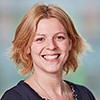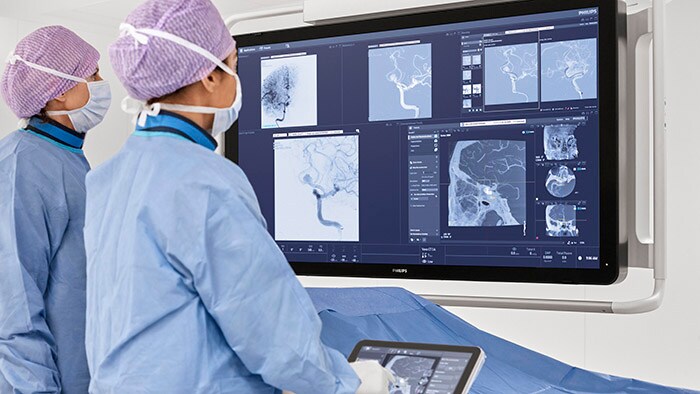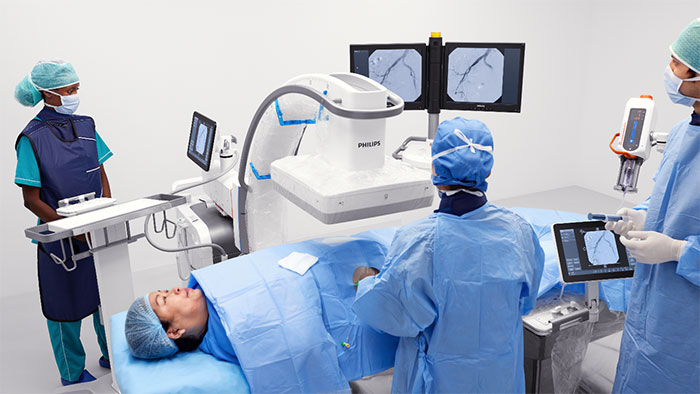May 03, 2022
Philips at ESOC 2022: showcasing integrated solutions across the stroke care pathway
Amsterdam, the Netherlands – Royal Philips (NYSE: PHG, AEX: PHIA), a global leader in health technology, will showcase its latest advances in its integrated suite of solutions for the treatment of stroke patients at the 2022 European Stroke Organisation Conference (ESOC 2022, May 4-6, Lyon, France). With its suite of solutions, Philips is connecting information, technologies and people across the stroke care pathway, enabling care teams to work quickly and act decisively - a key factor in providing the best patient treatment.
With our integrated suites, and by using validated AI and cloud technologies, we can facilitate collaborative care to optimize the stroke care pathway from diagnosis to treatment.
Bert van Meurs
Chief Business Leader for Image Guided Therapy at Philips
“Every second counts for someone suffering a stroke, so optimizing the workflow across the entire care pathway offers the best chance of improving outcomes,” said Bert van Meurs, Chief Business Leader for Image Guided Therapy at Philips. “With our integrated suites, and by using validated AI and cloud technologies, we can facilitate collaborative care to optimize the stroke care pathway from diagnosis to treatment.”
Stroke remains the leading cause of disability
Globally, one in four adults over the age of 25 will suffer a stroke in their lifetime [1]. Stroke is the leading cause of disability and the second leading cause of death worldwide [2]. 40% of stroke victims experience moderate to severe impairments , with another 25% continuing to suffer minor impairments [3].
The key to improving outcomes for stroke patients is to provide treatment as quickly as possible. Physicians in an emergency stroke setting are fighting the clock and are under intense pressure to make optimal treatment decisions. Despite the imperative for speed, care teams currently lose valuable time due to gaps in communication, information and access to stroke expertise.
Solutions across the stroke care pathway
Philips’ comprehensive stroke suite includes solutions for stroke monitoring and communication in ambulances, tele-stroke patient assessment, diagnostic imaging and analysis, image-guided therapy, neurological monitoring and assessment, and more. These solutions are aimed at improving diagnostic confidence, improving time to treatment, and helping reduce the risk of a second stroke.
In the case of ischemic stroke, CT angiography (CTA) is used for vessel analysis and CT perfusion (CTP) for the assessment of ischemic tissue in terms of that which is salvageable (penumbra) and unsalvageable (infarct core). Spectral CT 7500 can improve diagnostic capabilities for radiologists. It offers enhanced gray and white matter differentiation [4], improved image quality for detection of subtle hemorrhage [5] and may help in detection of ischemic stroke through enhanced visualization of vascular anatomy.
Philips Neuro suite is based on the company’s Image Guided Therapy System – Azurion. It is delivering the latest advancements in interventional neuroradiology, such as the company’s industry-leading CT-like SmartCT which provides a 3D visualization and measurement tool to assist interventional neuroradiologists with diagnosis and treatment, enabling them to get stroke patients into treatment quickly.
Philips is also integrating cloud-based, end-to-end artificial intelligence-based [6] stroke triage and management through StrokeViewer – for which it collaborates with Nico.lab – aiming to improve patient outcomes by optimizing the stroke workflow.
WE-TRUST global multicenter stroke study
To help accelerate stroke diagnosis and treatment, Philips is sponsoring the WE-TRUST trial (Workflow optimization to rEduce Time to endovascular Reperfusion for Ultra-fast Stroke Treatment). In this trial, a new angio suite imaging protocol, called the Direct to Angio Suite approach, is implemented to allow for stroke diagnosis and treatment to occur in the same place. The study will compare this approach with the conventional workflow of diagnosing patients for treatment in the CT or MRI suite and then treating them in a separate angio suite.
“A direct transfer to angiosuite protocol not only minimizes workflow times and reduces the long term disability in our patients, but also substantially reduces the associated costs,” said Dr. Marc Ribó, WE-TRUST Co-Principal Investigator, Interventional Neurologist at the Vall d’Hebron University Hospital and Researcher at the Stroke Research Group at the Vall d’Hebron Research Institute. “The model which we created based on our single center randomized clinical study data from the ANGIOCAT study and the cost related data per mRS shows a fast return of investment on a dedicated angiosuite treating patients in a Direct-To-AngioSuite workflow.”
Dr. Marc Ribó will present the results of the health economics of the Direct to Angio Suite approach during the symposium on Wednesday, May 4 which begins at 13:15 in Salon Pasteur at ESOC. You can find more information on his presentation here.
Post-stroke remote telemetry
Heart rhythm irregularities can lead to blood clots and increase the risk of stroke. It can increase the risk of stroke by more than five times [7], but it often goes undetected since it can be asymptomatic and may occur infrequently. Therefore, it is important to record the details of the irregularities especially in the days and weeks after therapy. [1] World Stroke Organization
Philips ePatch offers a small unobtrusive sensor and patch adhered to the patient’s sternum for up to 14 days of continuous, high-quality ECG recording for reliable diagnosis [8]. Philips also provides an end-to-end service to support practices to deploy ePatch, enabling efficient workflows, enhancing the patient experience and providing robust data analysis using the company’s cloud-based AI-enabled Cardiologs software.
New research evaluating mobile cardiac outpatient telemetry (MCOT) as a first-line diagnostic home monitoring solution with post-cryptogenic stroke patients determined that a 30-day continuous monitoring program using Philips BioTel Heart MCOT® patch [9], followed by an implantable loop recorder (ILR), reduced the total cost per patient with detected AF by approximately $198,909 [10] compared to monitoring with ILR only. The model also demonstrated improving AF detection rates while reducing the risk of secondary stroke. This research strengthens recommendations for prolonged ECG monitoring for this patient population.
[2] Global Burden of Stroke, PubMed.
[3] U.S. National Stroke Association
[4] Neuhaus V, et al. Improvement of image quality in unenhanced dual-layer CT of the head using virtual monoenergetic images compared with polyenergetic single-energy CT. Invest Radiol. 2017;52(8):1. DOI: 10.1097/RLI.0000000000000367.
[5] Gulko E, et al. Differentiation of hemorrhage from contrast enhancement using dual-layer spectral CT in patients transferred for acute stroke. Clin Imaging. 2021;69:75–78. DOI: 10.1016/j.clinimag.2020.06.046.
[6] We embrace the following formal definition of AI (source: HLEG definition AI)
[7] Virani SS, Alonso A, Aparicio HJ, et al. American Heart Association Council on Epidemiology and Prevention Statistics Committee and Stroke Statistics Subcommittee. Heart disease and stroke statistics-2021 update: a report from the American Heart Association. Circulation. 2021 https://pubmed.ncbi.nlm.nih.gov/33501848/
[8] Patient will need to replace patch on day 5 of wear, or sooner as required
[9] Philips BioTel Heart MCOT® patch is only for sale in the U.S.
[10] Difference in cost per patient with detected AF monitored with ILR ($228,507) minus cost per patient with detected AF patients using the MCOT patch ($29,598). Medic G, Kotsopoulos N, Connolly MP, Lavelle J, Norlock V, Wadhwa M, Mohr BA, Derkac WM. Mobile Cardiac Outpatient Telemetry Patch vs Implantable Loop Recorder in Cryptogenic Stroke Patients in the US - Cost-Minimization Model. Med Devices (Auckl). 2021 Dec 18;14:445-458. doi: 10.2147/MDER.S337142. PMID: 34955658; PMCID: PMC8694406.
About Royal Philips
Royal Philips (NYSE: PHG, AEX: PHIA) is a leading health technology company focused on improving people's health and well-being, and enabling better outcomes across the health continuum – from healthy living and prevention, to diagnosis, treatment and home care. Philips leverages advanced technology and deep clinical and consumer insights to deliver integrated solutions. Headquartered in the Netherlands, the company is a leader in diagnostic imaging, image-guided therapy, patient monitoring and health informatics, as well as in consumer health and home care. Philips generated 2021 sales of EUR 17.2 billion and employs approximately 79,000 employees with sales and services in more than 100 countries. News about Philips can be found at www.philips.com/newscenter.
Topics
Contacts

Joost Maltha
Philips Global Press Office Tel: +31 6 10 55 8116
You are about to visit a Philips global content page
Continue
Fabienne van der Feer
Philips Image Guided Therapy Tel: + 31 622 698 001
You are about to visit a Philips global content page
ContinueMedia assets












